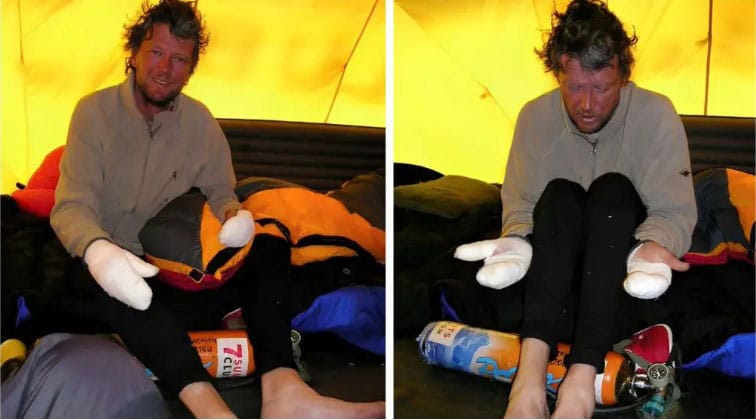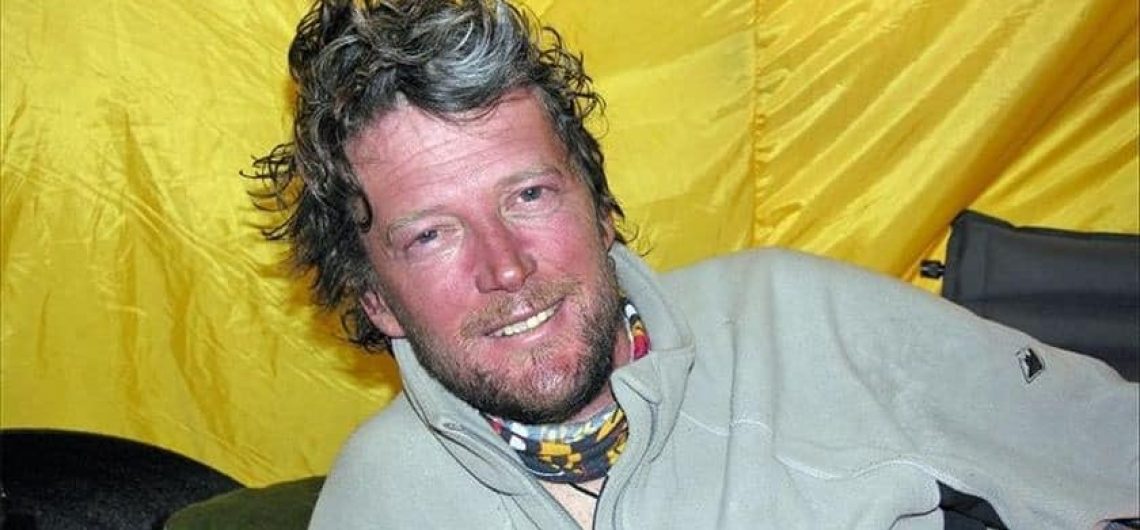Lincoln Hall’s crazy story has more questions than answers. I mean how on earth can you survive in the death zone of Everest after your colleagues leave you for dead overnight.
When he was discovered, he was stranded on the mountain with minimal clothing as a result of cerebral oedema impairing his cognitive abilities. Despite his extensive experience as a climber and mountaineer, he suffered severe mountain sickness. His survival was made possible by the combined efforts of two teams, one of which included a man who selflessly abandoned his own summit attempt, a group of sherpas who risked their lives to rescue him, an expert doctor who was on site, and several months of necessary aftercare. The blackened areas on his fingertips are the result of severe frostbite that caused major tissue damage, ultimately leading to the loss of those fingertips.
Lincoln Ross Hall OAM (19 December 1955 – 20 March 2012) was an experienced Australian mountain climber, adventurer, and writer. In 1984, he was part of the first Australian team to climb Mount Everest, where they created a new route. He successfully reached the summit of the mountain in 2006 on his second attempt, even surviving a night at 8,700 m (28,543 ft) on the descent after being left for dead. Lincoln Hall passed away in Sydney at the age of 56.
Lincoln Hall, a writer of seven books, a founding member of the Australian Himalayan Foundation, and a speaker who shared his climbing adventures worldwide was acknowledged in 1987 with a Medal of the Order of Australia for his contributions to mountaineering. In 2010, he was honoured with the Australian Geographic Society’s Lifetime of Adventure award. He was also a life member of the Australian National University Mountaineering Club. Unfortunately, Lincoln Ross Hall passed away at the age of 56 on March 20, 2012, due to mesothelioma.
In 1984, Mr Hall was a member of the initial Australian team to successfully reach the summit of Everest without the aid of oxygen. During the expedition, they encountered a dangerous avalanche, but despite the peril, two team members were able to reach the summit. Mr Hall decided to turn back just a few hours shy of the top as it became apparent that pressing on would have posed a serious risk to his physical well-being.

Who was Lincoln Hall?
Hall was born in Canberra, Australia and attended Telopea Park High School. He pursued a degree in Zoology at the Australian National University and gained experience in climbing at various crags in the Australian Capital Territory, including at Booroomba Rocks, where he established several well-known routes. He honed his ice-climbing abilities at Blue Lake in the Snowy Mountains and practised climbing by traversing the walls of buildings on his university campus.
Mountaineering
Hall’s mountaineering career took off when he joined the Australian National University Mountaineering Club expeditions to New Zealand from 1975 to 1978. The climax of this period was the 1978 expedition to climb the Himalayan peak Dunagiri in India. Hall and his climbing partner Tim Macartney-Snape were asked to join the expedition leader, Peter Cocker, at Col Camp to help create a route to the summit ridge. After spending a night on the mountain, they made a daring push for the summit, and Hall played a crucial role in Macartney-Snape’s successful bid to reach the top.
The two individuals braved their way through a powerful storm, and despite this, Hall ended up spending an additional night on the mountain. In the meantime, Cocker made his way up the mountain during the night and finally met Hall at the top of the fixed ropes, safely guiding him back to Col Camp. Following this, the ANUMC team rushed Hall down to Base Camp, from where he was airlifted to a Military Hospital near Delhi. This was considered one of the most challenging helicopter rescues in the Himalayas at that time. The successful Dunagiri trip organized by the ANUMC led to the partnership of Hall and Macartney-Snape, which laid the foundation for their future careers in Himalayan mountaineering, including their 1984 expedition to Mount Everest.
After climbing Dunagiri, Hall went on to lead numerous expeditions around the globe, which included many significant accomplishments by Australian climbers. His trips included two attempts to conquer Mount Everest in Nepal, resulting in the first successful Australian climb in 1984. He also achieved the first known traverse of Mount Minto in the Admiralty Mountains of Antarctica in 1998. He also successfully ascended other noteworthy peaks such as Annapurna II in Nepal, Makalu on the border of China and Nepal, and Carstensz Pyramid in Irian Jaya, Indonesia.
Rescue on Everest
In 2006, Lincoln Hall underwent a harrowing experience on Mount Everest. Suffering from altitude sickness, likely cerebral edema, at an altitude of 8700m, he was left for dead while descending from the summit on 25 May 2006. Hall began to hallucinate and become disoriented, prompting his Sherpa guides to try to rescue him for hours. However, as night fell, their oxygen supplies dwindled and snow blindness set in. Eventually, expedition leader Alexander Abramov instructed the guides to leave Hall on the mountain and return to camp, leading to a statement announcing his death to friends and family.
The following morning, 12 hours later, Hall was discovered alive by a group attempting to summit the mountain. The team was composed of Daniel Mazur from the U.S., Andrew Brash from Canada, Myles Osborne from the UK, and Jangbu Sherpa from Nepal. Osborne recounted the moment they found Hall just below the Second Step, stating, “Sitting to our left, about two feet from a 10,000 foot drop, was a man. Not dead, not sleeping, but sitting cross legged, in the process of changing his shirt.” Osborne described how Hall was not properly dressed or equipped, yet was surprisingly alive after spending the night without oxygen at 8,600m. This was a moment of disbelief for the entire team.
A massive rescue operation, unprecedented in scale according to mountain observers, immediately went into motion. Mazur and his team made the decision to abandon their summit attempt in order to remain with Hall, who was suffering from severe frostbite and was experiencing delusions due to cerebral edema. Simultaneously, Abramov organized a rescue team of 12 Sherpa guides from the base camp. The Sherpa guides included Ongshu Sherpa, Nima Wangde Sherpa, Passang Sherpa, Furba Rushakj Sherpa, Dawa Tenzing Sherpa, Dorjee Sherpa, Mingma Sherpa, Mingma Dorjee Sherpa, Pemba Sherpa, Pemba Nuru Sherpa, Passang Gaylgen Sherpa, and Lakcha Sherpa. Hall was eventually brought down the mountain, with the last part of the journey involving him walking to Everest’s North Col, where he was then treated by a Russian doctor Andrey Selivanov. He arrived at Advanced Base Camp the following day, in relatively good health despite suffering from frostbite and lingering effects of cerebral edema. He sadly lost part of his fingers and a toe due to frostbite.
Hall was saved and rescued not long after the passing of British climber David Sharp on the mountain. At first, no effort was made to save Sharp. While he was unconscious but still breathing, other climbers went by him and kept climbing. Unlike David Sharp, Hall was awake and capable of walking, which made it possible for him to be rescued. The incident had sparked worries, including remarks from Sir Edmund Hillary. Dan Mazur mentioned that when his team decided to give up their attempt to reach the summit, “The summit is still there and we can go back. Lincoln only has one life.”
After Everest
He maintained a close relationship with Myles Osborne, who gave up his only chance to climb Everest in order to help Hall. According to Osborne, Hall was “a wonderful person, very easygoing, and enjoyed telling bad jokes.” In 2006, the documentary “Left for Dead on Mount Everest” was broadcasted on Dateline NBC and was nominated for an Emmy Award. Hall authored two books about his ordeal: “Dead Lucky: Life after death on Mount Everest” in 2007 and “Alive In The Death Zone: Mount Everest Survival” in 2008. Another documentary, “Miracle on Everest,” was based on Hall’s book “Dead Lucky” and premiered in 2008 on National Geographic Channel in the USA and on ABC1 in Australia. Hall’s story was also featured in an episode of “I Shouldn’t Be Alive” titled “Left for Dead on Everest” which aired on 16 February 2011.
Death
Hall passed away on March 20, 2012 at the Royal Prince Alfred Hospital in Sydney after battling mesothelioma. His friend and fellow mountaineer, Greg Mortimer, who was by Lincoln’s side at the end, described his passing as peaceful and meditative, with Lincoln eventually slipping away quietly. He had been living in the Blue Mountains in New South Wales, with his wife and two sons, who survived him. His death was announced on the website of the Australian Himalayan Foundation, a cause he had helped establish. Australian newspapers reported that he had succumbed to mesothelioma due to childhood exposure to asbestos.
![]()


Comments